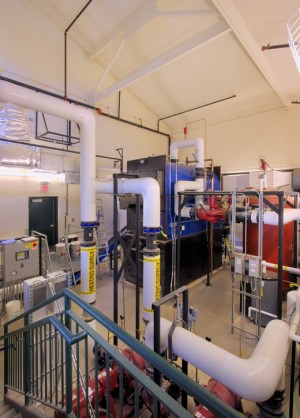
Merrimack Valley High School Wood Chip Plant Boiler Room
Using wood as chips or pellets as a primary fuel for both space and domestic water heating in schools and commercial buildings is an active and growing part of Banwell Architects practice. Aside from fireplaces and wood stoves, our first modern biomass heating installations, starting in 1994 were in schools as part of Vermont’s pioneering funding incentives to encourage this local and renewable resource to as a way to reduce the use of fuel oil.
Banwell Architects has thirteen completed biomass heating installations, two others in construction, two more on the boards and several others in proposal, evaluation or feasibility stages.
This historic, or more accurately, prehistoric fuel source is now an established and rapidly developing technology. Advances include significant gains in combustion efficiency, approaching levels previously only available with fossil fuels. This has been possible with innovative, research-driven designs of combustion equipment, either direct combustion or two stage gasification and combustion.
Automated fuel handling is another area where innovation is critical and rapidly advancing. From production; chipping and use of wood mill waste, manufacture of commodity-level wood pellets to delivery; live-action moving floors on enclosed truck trailers for woodchips or bulk pellet truck indistinguishable from fuel oil trucks using pneumatic boom-mounted tubes and augurs to eliminate manual handling. There is also a wide variety of methods to take stored biomass fuels and deliver reliably to combuster as needed to meet heating demands. These automated systems typically include digital controls integrated with building-wide temperature control systems with easy adaptability for remote web-based system monitoring, status reports and controls.
Emission control is another rapidly advancing aspect of modern biomass systems. Computer-based emission modeling is typically done to analyze dispersion using local weather data. Devices ranging from cyclone collectors to electrostatic precipitators are used to pull fine particulates from exhaust gases before reaching the stack, or chimney. Testing is often included to confirm projected performance. Combined with high efficiency combustion, these devices leave only a pale plume of condensing water vapor at the top of the stack.
We are also seeing increasing scalability in biomass heating systems. Our completed systems have ranged from a few hundred thousand BTUs (British Thermal Units) to over 7 million BTUs. We are also seeing increased interest in electricity co-generation, using heat-led steam systems with a turbine to make power available for facility use or by means of net-metering, for export to power grid.
The question is often asked, “…can our New England forests really sustain increased harvesting for growing woodchip or wood pellet use?” Considering the scale of previous harvest demands for the paper industry, up to 1 million tons/year, now unfortunately nearly nothing; current and projected biomass heating demands are less than 10% of that level. The Biomass Energy Resource Center, a Montpelier, VT based non-profit studies this sustainability question and maintains a thorough database on past and projected consumption compared with forest regeneration. Use of other biomass crops such as corn and grasses is also developing.
It’s important to note that biomass heating is particularly appropriate for the Northeast United States. First because of our extensive forest cover and developed forest industries. Combined with our region’s dependence on heating fuel oil, largely imported, often from unstable areas of the globe at prices that our beyond our control; locally harvested, sustainable supports our economy and provides a measure of energy security and predictability. Since these trees, limbs or woodmill waste products would otherwise rot, biomass fuels are effectively carbon-neutral. This helps slow greenhouse gas emissions from fossil fuels and can slow climate change.
For all these reasons, Banwell Architects is pleased to help with study, development and implementation of biomass heating projects. We have developed an experienced team of consultants; scientists for emissions modeling and permit assistance, engineers for site development, for integrated mechanical and electrical systems and commissioning agents to ensure performance levels are met. We direct and coordinate these efforts to ensure project success.
Please contact Banwell Architects for evaluation of your project’s or your facility’s potential for biomass heating. We can evaluate scope and cost of implementation and compare with data on operational savings for long term life cycle cost analysis, payback and return on investment. We can also help with potential supplemental funding sources. If favorable we can then design and assemble construction documents to help bring unpredictable heating costs in your control.


